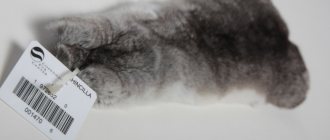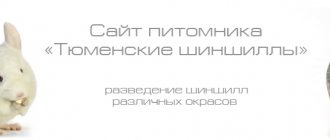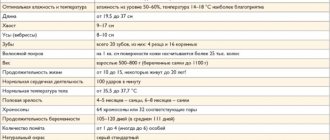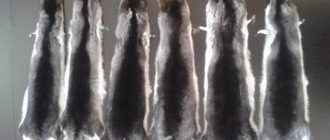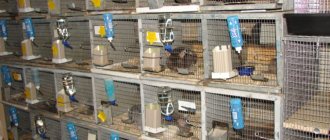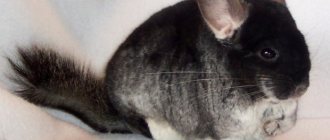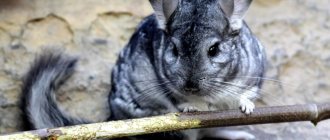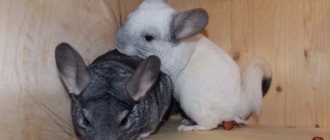When purchasing a furry animal as a pet, you need to know that a chinchilla, like any other rodent, has teeth that grow constantly. The animal is forced to grind them down and therefore constantly gnaws on something hard. And the owner’s task is to ensure that the animal always has solid objects in its cage, such as, for example, mineral stones for chinchillas.
What stones are there for chinchillas?
Not all animals have the same characters and taste preferences. Therefore, it will not be possible to understand in advance which minerals are suitable for a particular rodent.
In the assortment of specialized stores you can find different types of mineral stones for chinchillas:
- loamy;
- salt;
- chalk – mineral;
- chewing;
- minerals containing vitamins and probiotics;
- natural pumice of volcanic origin.
Which branches are suitable for pets?
Every veterinarian knows which branches are useful for hamsters. Beginning breeders should pay attention to the fact that this is a product mainly from fruit trees such as cherries, plums, apple trees, sweet cherries and others. If you are concerned about which branches can and cannot be given to hamsters, it is best to contact a veterinary pharmacy or pet store.
Having found out what branches and stones a hamster can eat, you should take into account that cherry, apricot pits, and shoots from coniferous trees are prohibited. The reason for the ban is the content of resins in the products, which negatively affect the functioning of the internal organs of animals. You should give preference to products purchased at pet stores, however, you can also prepare twigs yourself.
Loamy stone
This is a natural material that many rodents enjoy using to wear down their teeth. In addition, it contains minerals necessary for the animal’s body.
JR FARM stone (best suited to the needs of a chinchilla) consists of natural clay with the addition of wheat, roses and marigold. It contains no artificial ingredients or preservatives. Therefore, it will not cause any harm to the rodent. Composition of loamy stone from this manufacturer:
- protein content – 1.3%;
- fat - 0.5%;
- fiber – 2.3%;
- ash – 89.1%.
Vitamins for rodents
Any rodent may need special supplements, but weakened pets (sick or pregnant) need them especially. Before administering such vitamins, the animal should consult a doctor so as not to cause harm to the sick animal.
A healthy animal may require supplements to compensate for certain element deficiencies in the body. Vitamins for guinea pigs, chinchillas, ferrets and rabbits contain basic natural additives and do not harm the physical condition of the animals.
salt stone
It is better to place minerals containing sodium and other substances necessary for the chinchilla’s body closer to the animal’s drinking bowl. After the teeth grinding procedure, the animal will immediately want to drink.
This Vitakraft Vita Fit Sel plus product has proven to be of good quality, in which the substances necessary for a rodent are organically combined.
Treats
Today, the pet store can offer another option for grinding teeth - grain sticks. They come in different grain compositions with the addition of various minerals and trace elements. This delicacy will definitely please your taste! You can also prepare your hamster’s liver yourself!
cereal sticks
In addition, if you tie the treat in such a way that the hamster has to work hard to get to it, then it will also serve as good entertainment and additional physical activity for your pet.
A hamster should not chew ordinary school chalk; after all, it is non-food and is not intended for such purposes. Food products undergo several degrees of purification, so they are safe for the animal.
Which stone should you choose?
When purchasing abrasive materials for chinchillas, you should give preference to those that:
- have a completely natural composition;
- do not contain substances such as chlorine, lime, iron, aluminum;
- have a natural smell.
The stones should also not contain dyes, otherwise the pet may acquire an unusual color: yellow, pink or green. In addition, dyes have a harmful effect on the animal’s body. The same applies to the various preservatives that some manufacturers include in the composition of the stones.
Often mineral stones for chinchillas are sold in bars that cannot be attached to the animal’s cage. They often fall with a lot of noise, frightening the already impressionable animal. They can also get dirty, wet, and then deteriorate.
It is better to buy minerals that have wire for attaching them to the bars of the cage. Then the rodent will be able to grind down the incisors in a comfortable position.
Kinds
There are different types of stones. It is worth considering them in detail:
- Salt stones. They contain table salt. This stone is suitable exclusively for herbivorous rodents, such as decorative rabbits and guinea pigs. Their usual diet is dominated by hay and grass. This is why they need additional salt feeding. Rats don't need it. Therefore, salty stones should not be given to them.
- Note that some manufacturers add flavorings and dyes to stones and other treats for rodents. As a rule, such stones attract more attention from animals. But you need to make sure that your pet does not develop an allergy to these components.
- Loamy stones are a suitable option. Sometimes salt is also added to them.
- Sepia (cuttlefish shell). This is an excellent alternative to mineral stone for rodents.
- School regular white chalk. Can be used, but as an exception. If you take this kind of chalk, make sure that there is not a large amount of gypsum in the composition.
Minerals with added chalk
When chinchilla stones contain chalk, along with salt, minerals and pumice, many owners of these animals do not understand why this is needed. Let's figure it out.
Stationery types of chalk (those used to write on the blackboard at school) differ in their composition from natural material, which does not contain chemical additives harmful to rodents.
Chalk, which is formed in nature, may also differ in chemical composition. Everything will depend on the place where it was mined.
Some types of calcium salts can cause constipation in an animal. Therefore, it is necessary to offer him chalk as an abrasive in rare cases when the rodent himself insists on it. And besides this, it needs to be alternated with other types of minerals.
Factory-made and natural food for chinchillas
The best boxed foods are: Versele Laga Chinchilla & Degu Pro, Vitakraft Vita Special, Vitakraft Pellet. Please note that high-quality food is homogeneous granules. Do not purchase granules containing cereal grains, seeds, multi-colored balls and other inclusions.
Hay is another important element of a chinchilla's diet. It is known that hay contains large amounts of fiber, so it contributes to the proper formation of boluses (feces). In addition, chewing hay helps animals wear down their chewing teeth. However, the hay must be of high quality: green in color, with a natural fresh aroma, without dirt and dust. And most importantly, hay should not be placed in the animals’ cage, since the chinchilla will eat the hay with excrement. And this is fraught with bloating and even, in some cases, poisoning.
Water for chinchillas should be filtered or factory-made drinking water, with a minimum level of mineralization. Do not use boiled or carbonated water, much less tap water. Fluid intake fluctuates throughout the day. It depends on the animal’s age, weight, activity of the furry pet and other factors.
What to do when your chinchilla won't chew a rock
To determine your pet's mineral preferences, they are given the opportunity to choose from several options.
It may also be that the chinchilla's stone remains untouched for several weeks, and then she chews it overnight. Therefore, you should not rush to remove the mineral if the animal does not react to it.
Form matters too. If the minerals have rounded edges, the rodent may not like it (the chinchilla prefers to sharpen its teeth on sharp edges). Therefore, the stone is broken into two parts.
In order to serve their intended purpose for as long as possible, stones for chinchillas, and especially pumice, should not get wet or be exposed to direct sunlight.
Did you like the article? Share with friends: [supsystic-social-sharing id=”1"]
- Related Posts
- Types and breeds of chinchillas
- How to make safe toys for chinchillas with your own hands
- Chinchilla diet at home
« Previous entry
Branches for grinding down incisors
tree branches
How to sharpen the teeth of hamsters who ignore pebbles and special toys and continue to chew on the cage? Try adding special branches for hamsters, which can be purchased at pet stores. You need to be careful when harvesting twigs yourself, as they contain harmful resins. If, despite the warnings, you decide to prepare the branches yourself, cut the branches so that the baby does not get hurt, and collect the branches away from the road. You can cut a few branches of a pear, cherry or other fruit tree, but provided that they have not been treated with chemicals, otherwise there will be more harm than good.
Choose young branches of fruit trees, as thick as your little finger and 5-6 cm long. The tree is a good and environmentally friendly sharpener for incisors. There is no need to peel off the bark; rodents really like it. With the help of wood, the incisors are ground down evenly and softly.
Friends of Uglochikha
We have previously mentioned the size of the cage and the house . What else should a chinchilla have at its disposal? In this article we tried to consider in some detail the basic equipment for a happy life for your pet.
Drinking bowl
There are several types of drinkers: open type, nipple and ball. An open-type drinking bowl is not very convenient, as water will splash around and quickly get dirty in the feeder. The nipple drinker has a thin spout and not all chinchillas drink from it. It is best to use a ball drinker with a glass container and a metal tip. It is recommended to attach it to the outside of the cage. This is practical when changing water, does not take up space inside the cage, and the rodent will not damage the drinking bowl if it has plastic parts. Remember that water should always be fresh and filtered!
Feeder
They also come in different types: suspended metal, ceramic and plastic. Stability is important in the feeder so that the animal does not turn it over and scatter the food. Therefore, the best option would be a hanging feeder with a lock (on a nut). To create additional support for the bowl with the retaining ring, you can use a rubber band or a clamp. Ceramic is also suitable as it is heavy. But you shouldn’t use a plastic one, because it’s light and a chinchilla can chew it.
Sennitsa
It is best to use a square one with an open top or a closed cylindrical one with a fine mesh. It is important to monitor the quality of the hay and change it every day. You should remove hay from the floor, because the chinchilla will walk on it, dirty it, and then might eat it.
ATTENTION: the ball-shaped haybox cannot be used! Breeders have long received the name “Death Ball”. Since chinchillas are very flexible, they can climb up there, get stuck and be seriously injured.
Stones
Chinchillas' teeth are constantly growing, so it is necessary to grind them down. Special stones for sharpening teeth will help with this. There are also stones to maintain mineral balance in the body. There can be several types in a cell:
- carbonaceous stones;
- salt stones (it is better to hang them near the drinking bowl);
- salt lick;
- mineral stone (with vitamins or probiotic);
- mineral chalk stone (must be in the cage);
- chewing stone for teeth;
- natural, volcanic pumice (for grinding teeth).
Bathing suit
Let us remind you that chinchillas bathe only in special sand and cannot be washed in water, much less with shampoo. The sand should be poured into a special container for bathing. It is best to use bathing suits with high brims, as chinchillas like to roll around and dig around, and the sand can spread out. The procedure takes 10-15 minutes, no more than 2 times a week.
running wheel
Like any animal, a chinchilla needs physical activity for a healthy and long life. Be careful when choosing running equipment. If you purchase a wheel, it should be made of fine mesh so that the animal’s paws do not get stuck and are damaged. The minimum diameter should be 28-30 cm, the optimal - 38-40 cm. The best option would be a wooden wheel that is completely closed on one side (where the mount is) and completely open on the other. These wheels can be made to order.
Tunnel or hammock
In order for your pet to feel comfortable and not bored in his cage, we suggest placing a hammock or tunnel. It is best to have a hammock in the form of a tube made of natural dense fabric, attached to a chain. The tunnel provides an interesting means of transportation that will add variety to your cage; some chinchillas even like to rest there.
Toilet
Most chinchillas are easily toilet trained. You just need to fill it with sawdust, wood pellets or corn filler. Buy litter without fragrances, as chinchillas will eat it. You can use a special toilet with a grate (to prevent the filling from scattering) or without, as well as glass containers (for example, baking dishes).
Granite slab
The room temperature should not exceed 23 degrees, the optimal temperature is 18-22 degrees Celsius. If you don't have air conditioning, a granite slab for cooling will help solve some of the heat problem. Cold storage batteries for travel refrigerators are still sold now; you can keep them in the freezer in particularly hot weather, and then put them around the cage to keep your chinchilla cool.
Scales
This may surprise you a little, but the chinchilla should still be weighed periodically to observe the dynamics of growth and weight. Overeating or poor nutrition can cause many problems for your chinchilla, so keep a close eye on your pet and what he eats.
Setting up a cage for a chinchilla
